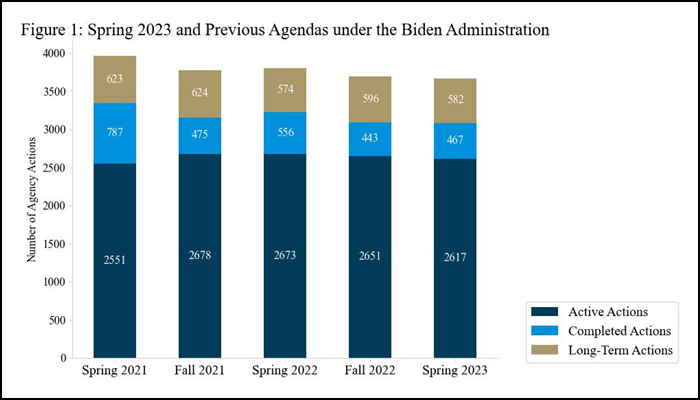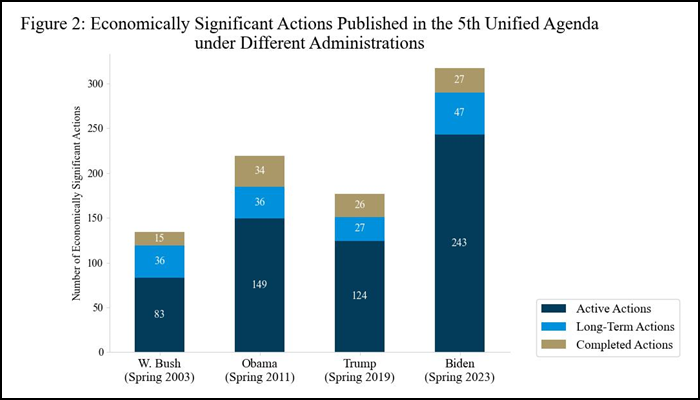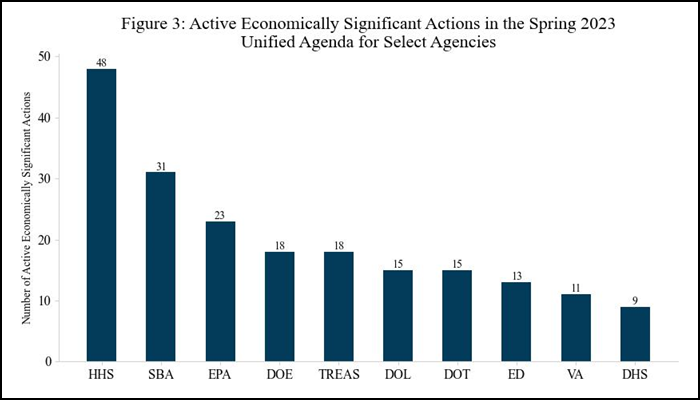Download this commentary (PDF)
In Brief ...
The Spring 2023 Unified Agenda has minimal changes in the number of actions compared to the Biden administration’s previous Agendas. Many of the active economically significant actions reflect agencies’ continued efforts demonstrated in previous Agendas, while the others indicate agencies’ intention of initiating rulemakings in new areas.
Introduction
On June 13, the Office of Information and Regulatory Affairs (OIRA) released the Spring 2023 Unified Agenda. The Unified Agenda contains information about regulatory actions in development or recently completed by federal agencies. This release marks the Biden administration’s fifth Unified Agenda. This commentary gives an overview of the Agenda and highlights notable actions that agencies plan to issue in the near term.
What’s in the Spring 2023 Agenda?
The Spring 2023 Unified Agenda contains a total of 3,666 agency actions, including 317 economically significant actions—those with an expected annual effect of more than $100 million as defined in Executive Order (EO) 12866 (Table 1).[1] It lists actions by stage of development: 2,617 are active (the next agency action is expected within 12 months), 582 are long-term (beyond 12 months), and 467 are completed (rules finalized or withdrawn since the previous Unified Agenda was published).
Among the 2,617 active actions, 343 (approximately 13%) are being published for the first time in this Unified Agenda, and 243 are economically significant actions (of which 16 are published for the first time).
The numbers of actions in this Agenda are comparable to previous Biden administration Agendas (Figure 1). There are small declines in the number of actions from the Fall 2022 Agenda. The number of active actions changed from 2,651 to 2,617, a 1.3% reduction. The number of economically significant actions decreased by 4.5% compared to the Fall 2022 Agenda (from 332 to 317), of which the number of active economically significant actions remains almost the same (from 244 to 243).
Table 1: Overview of the Spring 2023 Agenda
| Stage | All Agency Actions | Economically Significant* | First Time Published |
|---|---|---|---|
| Active | 2,617 | 243 | 343 |
| Long-term | 582 | 47 | 27 |
| Completed | 467 | 27 | 61 |
| Total | 3,666 | 317 | 431 |
* Economically significant actions based on the original definition of EO 12866, including Section 3(f)(1) significant actions defined in EO 14094.
Economically significant actions are a particularly useful measure to gauge the priorities and regulatory output of a presidential administration. The number of economically significant actions published in the Spring 2023 Unified Agenda is substantially higher than those published in previous administrations’ fifth Agenda—a phenomenon also observed for previous Agendas (Figure 2). The increase is mostly driven by the number of active rulemakings, partially attributable to continued post-COVID actions such as the Paycheck Protection Program.
Active Economically Significant Actions by Agency
Breaking down the active economically significant actions by agency reveals ongoing priorities reflected in the Unified Agenda. As shown in Figure 3, the agencies with the highest number of active economically significant actions planned include the Department of Health and Human Services (HHS), the Small Business Administration (SBA), the Environmental Protection Agency (EPA), the Department of Energy (DOE), the Department of the Treasury (TREAS), the Department of Labor (DOL), the Department of Transportation (DOT), the Department of Education (ED), the Department of Veterans Affairs (VA), and the Department of Homeland Security (DHS). Together, these agencies are responsible for 201 active economically significant actions, over 80% of such actions in the current Agenda.
Like the previous Biden Agendas, HHS is working on the largest number of economically significant rules. More than half (26) of these active actions come from the Centers for Medicare and Medicaid Services (CMS). Many of these CMS rules deal with recurring actions related to Medicare and Medicaid programs, such as payment system rates and quality reporting updates for the upcoming fiscal and contract year. The Food and Drug Administration (FDA) plans to take 11 actions in the near term. Several of those actions are related to tobacco products, which were also included in the Fall 2022 Agenda, including standards for characterizing flavors in cigars, menthol in cigarettes, and nicotine levels of certain tobacco products. Appearing for the first time in the Unified Agenda, FDA is initiating a rulemaking requiring front-of-package nutrition labeling as well as an action establishing registration and good importing practice requirements for commercial importers of drugs.
The Substance Abuse and Mental Health Services Administration (SAMHSA) of HHS plans to finalize its proposal on medications for the treatment of opioid use disorder. The action is intended to make permanent some regulatory flexibilities for opioid treatment programs granted under the COVID-19 public health emergency.
Like the Fall 2022 Agenda, SBA is the agency with the second largest number of active economically significant actions in the current Agenda, with almost all of those actions (30 out of 31) pertaining to the Paycheck Protection Program. Relatedly, six of the 18 actions from the Treasury Department also deal with the Paycheck Protection Program. Other Treasury actions include IRS guidance related to the definition of church plan, elimination of interbank offered rates, and foreign tax credit.
EPA expects to take 23 economically significant actions during the coming year. All of those actions were previously published in the Unified Agenda, reflecting the agency’s continued priorities on reducing greenhouse gas (GHG) emissions, PFAS, and other water and air pollutants. Many of the actions published in the previous Agenda are also included in the current Agenda, such as the Mercury and Air Toxics Standards (MATS) reconsideration, new source performance standards and emission guidelines for crude oil and natural gas facilities, vehicle emission standards for model years 2027 and later, and PFAS drinking water regulation and designation. In addition, EPA plans to finalize its May 2023 proposal addressing GHG emissions from fossil fuel-fired electric generating units, which would repeal the Affordable Clean Energy Rule. EPA is also moving forward with its rulemaking regulating coal ash, also referred to as coal combustion residuals (CCRs), as it plans to finalize its recent proposal establishing requirements for inactive surface impoundments at inactive facilities.
Other notable actions include DOL’s plan to finalize the 2022 proposal on the classification of a worker’s status as an employee or independent contractor, which would rescind the 2021 Independent Contractor rule. DOL, along with DHS, are also working on a proposed rule updating the process by which U.S. employers employ a nonimmigrant worker in H-2B status. DOT is initiating a rulemaking requiring passenger motor vehicles to be equipped with advanced drunk and impaired driving prevention technology. The Federal Trade Commission plans to finalize the non-compete clause rule that it proposed in January this year. With an advance notice of proposed rulemaking published in October 2022, the Federal Reserve Board and Federal Deposit Insurance Corporation are considering a proposal regarding whether requiring an extra layer of loss-absorbing capacity by certain large banking organizations would enhance financial stability and enhance resolution options.
Conclusion
Compared to the Biden administration’s previous Agendas, there are minimal changes in the number of actions published in the Spring 2023 Unified Agenda. Over 80% of the active economically significant actions in the Agenda come from 10 agencies, starting with HHS, SBA, and EPA. Many of those actions reflect agencies’ continued efforts demonstrated in previous Agendas, while the others indicate agencies’ intention of initiating rulemakings in new areas.
[1] The Spring 2023 Agenda adds a new category of “Section 3(f)(1) Significant” actions, those with expected annual impacts of more than $200 million. EO 14094 amended Section 3(f)(1) of EO 12866, which had set the threshold at $100 million and referred to rules above that threshold as “economically significant actions.” Only actions published after April 6, 2023 are categorized based on the new 3(f)(1) definition, while earlier actions that meet the new definition are still categorized as “Economically Significant” in the Agenda based on the original definition in EO 12866. Therefore, for consistency, the economically significant actions discussed in this commentary still refer to those with an expected annual effect of more than $100 million as defined in EO 12866. Of the 317 economically significant actions, 20 actions are categorized as “Section 3(f)(1) Significant” in the current Agenda.





